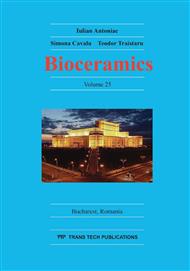[1]
Galembeck, F., Lima, E.C.O., Beppu, M.M., et al. Polyphosphate nanoparticles and gels- from macroscopic monoliths to nanoparticles. Nato Advanced Science Institute Series, v12, pp.267-279, (1996).
Google Scholar
[2]
LeGeros, R. Z., Chohayeb, A. e Shulman, A. Apatitic calcium phosphates: possible dental restorative materials. J. Dent. Res, v. 61, (1982).
Google Scholar
[3]
Dorozhkin, S. V. Calcium Orthophosphate Cements and Concretes. Materials, v. 27, pp.221-291, (2009).
DOI: 10.3390/ma2010221
Google Scholar
[4]
Tonoli, M. S.; Leal, C. V.; Zavaglia, C. A.; Beppu, M. M. Development and characterization of β- tricalcium phosphate cements containing chitosan. Key Engineering Materials, v. 309, pp.845-848, (2006).
DOI: 10.4028/www.scientific.net/kem.309-311.845
Google Scholar
[5]
Beppu, M.M., Santana, C.C. PAA influence on chitosan membrane calcification. Materials Science and Engineering C, v. 23, pp.651-658, (2003).
DOI: 10.1016/j.msec.2003.08.002
Google Scholar
[6]
Aimoli, C.G., Beppu, M.M. Precipitation of calcium phosphate and calcium carbonate induced over chitosan membranes: a quick method to evaluate the influence of polymeric matrix on heterogeneous calcification. Colloids and surfaces B, v. 53, pp.15-22, (2006).
DOI: 10.1016/j.colsurfb.2006.07.012
Google Scholar
[7]
Aimoli, C.G., Torres, M.A., Beppu, M.M. Investigations into the early stages of in vitro, calcification on chitosan films. Materials Science and Engineering C, v. 26, pp.78-86, (2006).
DOI: 10.1016/j.msec.2005.06.037
Google Scholar
[8]
Beppu, M.M., Aimoli, C.G. Influence on in vitro chitosan membrane biomineralization. Key Engineering Materials, v. 254, pp.311-314, (2004).
DOI: 10.4028/www.scientific.net/kem.254-256.311
Google Scholar
[9]
Aimoli, C.G., Nogueira, G.M., Nascimento, L.S., et al. Lyiophilized bovine pericardium treated with a phenetilamine-diepoxide as na alternative to preventing calcification of cardiovascular bioprosthesis: preliminary results. Artificial Organs, v. 31, pp.278-283, (2007).
DOI: 10.1111/j.1525-1594.2007.00376.x
Google Scholar
[10]
Bohner, M. Reactivity of calcium phosphate cements. Journal of Materials Chemistry, v. 17, pp.3980-3986, (2007).
Google Scholar
[11]
Rau, J. V. et al. Energy dispersive X-ray diffraction study of phase development during hardening of calcium phosphate bone cements with addition of chitosan. Acta Biomaterialia, v. 4, p.1089–1094, (2008).
DOI: 10.1016/j.actbio.2008.01.006
Google Scholar
[12]
Grover, L. et al. Temperature dependent setting kinetics and mechanical properties of β-TCP–pyrophosphoric acid bone cement. J. Mater. Chem., v. 15, pp.4955-4962, (2005).
DOI: 10.1039/b507056m
Google Scholar
[13]
Ginebra, M.P. Desarrolo y caracterización de un cemento óseo basado en fosfato tricálcico- α para aplicaciones quirurgicas. 1996. Dissertação (Doutorado em Ciências, Especialidade Física) – Departament de Ciências dels Materials i Enginyeria Metalurgica, Universitat Politécnica de Catalunya, (1996).
Google Scholar
[14]
Bohner, M.; Lemaître, J. Hydraulic properties of tricalcium phosphate – phosphoric acid – water mixtures. Journal of Materials Science Materials in Medicine, v. 8, (1993).
Google Scholar
[15]
Jinlong, N.; Zhenxi, Z.; Dazong, J. Investigation of phase evolution during the thermochemical synthesis of tricalcium phosphate. Journal of Materials Synthesis and Processing, v. 9, pp.235-240, (2002).
DOI: 10.1023/a:1015243216516
Google Scholar
[16]
ASTM-C266-04: Standard Test Method for time of setting of hydraulic-cement paste by Gillmore needles.
DOI: 10.1520/c0266-15
Google Scholar
[17]
Dosen, A.; Giese, R.F. Thermal decomposition of brushite, CaHPO4·2H2O to monetite CaHPO4 and the formation of an amorphous phase. American Minearalogist, v. 96, pp.368-373, (2011).
DOI: 10.2138/am.2011.3544
Google Scholar
[18]
Bohner, M., Merkle, H.P.; Lemaître, J. In vitro aging of a calcium phosphate cement. Journal of Materials Science Materials in Medicine, v. 11, pp.155-162, (2000).
Google Scholar


